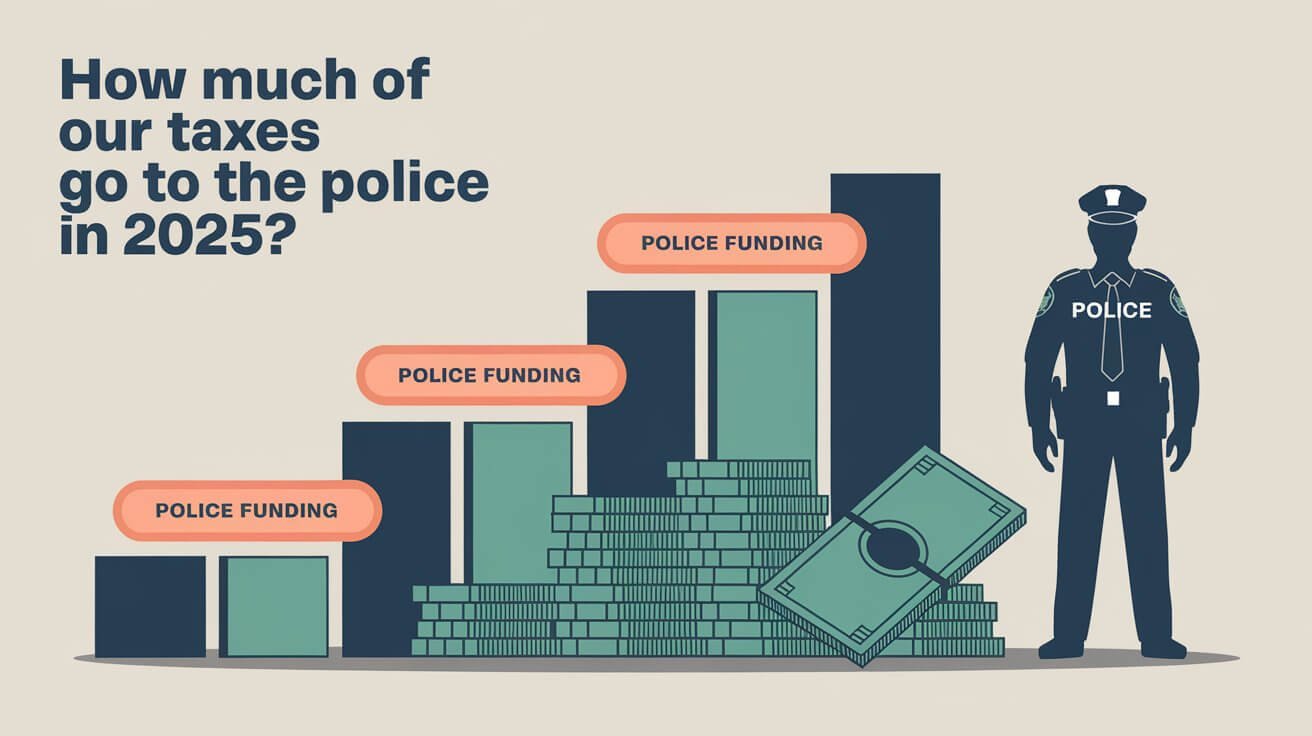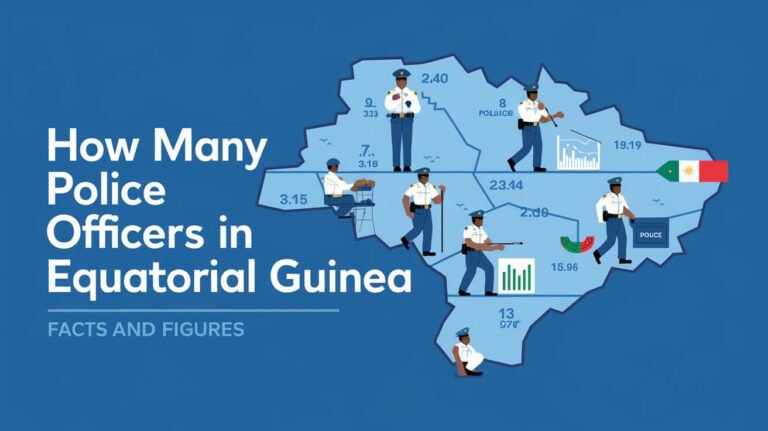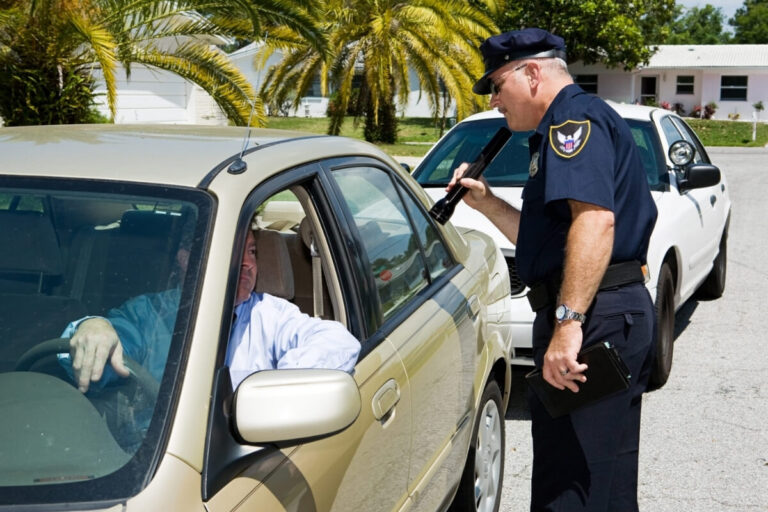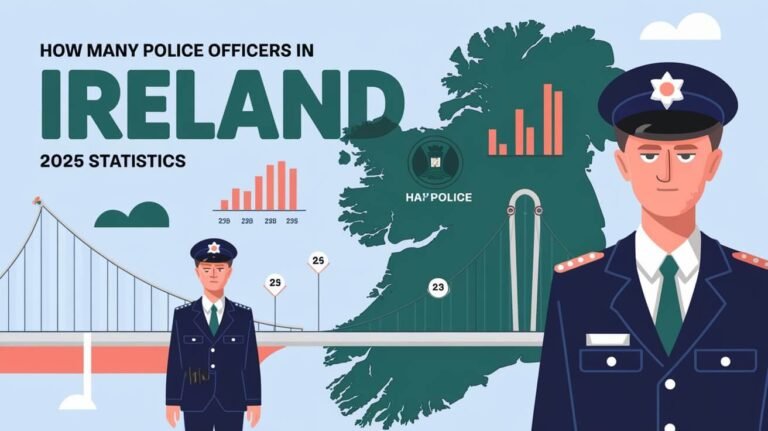How Much Of Our Taxes Go To The Police? in 2025

It’s important to know how our taxes are used, like for police funding. In 2021, states and local governments spent $135 billion on police. This is 4% of their total spending. It makes us wonder where our money goes.
Police funding is a big deal in our society. In 2021, each person in the U.S. spent $407 on police. Police budgets have grown from $47 billion in 1977 to $135 billion in 2021. We’ll look into how tax dollars help police and keep us safe.
Police Budget Sources in America
Law enforcement in the U.S. gets money from different places to keep us safe. The budget comes from the federal, state, and local governments. A big part of this money comes from local governments, showing how important police are to them.
How we spend on police is key to keeping everyone safe. In 2017, states and local governments spent $193 billion on police and corrections. Local governments spent $129 billion, which is two-thirds of that. This shows how much we value safety in our country.
Federal Tax Contributions
Federal taxes help a lot in funding police work. This money goes to many things like training, equipment, and more officers.
State Revenue Allocation
States also give money to police. This money helps with state-level police work, like highway patrols and investigations.
Local Property Tax Distribution
Property taxes are another big way to fund police. Local governments use these taxes to support their police departments. This ensures safety at the local level.
To sum up, police budgets come from the federal, state, and local governments. Knowing where this money comes from helps us understand how to keep our communities safe. It also shows how important it is to fund our police effectively.
Current Police Department Funding Models
The criminal justice system in the United States depends a lot on police funding. In 2017, state and local governments spent over $240 billion on cops, courts, and corrections. This includes $114.5 billion for police. This big investment is key for keeping us safe and running the justice system.
States spent $15.4 billion on police in 2017, which is 1.1% of their spending. Cities spent $62.9 billion, making up 13.5% of their spending. Most of this money goes to pay for salaries and benefits, which are vital for police work.
Some important facts about police funding are:
- State and local governments spent $240 billion on cops, courts, and corrections in 2017.
- Police funding accounted for $114.5 billion of the total expenditure.
- States spent $15.4 billion on police, while cities spent $62.9 billion.
Police funding is very important in the criminal justice system. A lot of police money goes to paychecks, showing how critical salaries and benefits are. With the current economic situation and possible budget cuts, it’s vital to think about how police funding will be affected.
| Level of Government | Police Funding (2017) | Percentage of Total Spending |
|---|---|---|
| State | $15.4 billion | 1.1% |
| City | $62.9 billion | 13.5% |
How Much Of Our Taxes Go To The Police: National Statistics
Looking at national statistics, we see how tax dollars are used for police. In 2021, state and local governments spent $135 billion on police. Most of this money came from local governments.
The way tax dollars are spent on police varies a lot between states. For example, Washington, D.C., spent the most per person, $1,410, while Arkansas spent the least, $419. Florida and Nevada also stand out, spending 7% and 6.9% of their budgets on police, respectively.
Municipal Police Spending
Municipal police spending is a big part of law enforcement budgets. In 2021, the U.S. spent $669 per person on police and corrections. This shows how much tax dollars go to police at the local level.
County Law Enforcement Budgets
County law enforcement budgets are also important. Blue states spent 28% more on police and corrections than red states in 2021. This shows how tax dollars are used differently in different areas.
State Police Allocations
State police allocations show how tax dollars are used for state-level law enforcement. California and Maryland were the top spenders per person on police and corrections. This highlights the different levels of investment in law enforcement across states.
Police Budget Variations Across States
Police funding varies a lot from state to state. The District of Columbia spent the most per person on police in 2021. California and Alaska followed closely. These differences come from many factors like population size, crime rates, and what local governments focus on.
In some states, a big part of the budget goes to police. For example, in Los Angeles, police spending was about half of the money available for other things. But when including money for things like transportation and housing, it’s closer to a quarter of the total budget. In California, police spending was 6% of all local government spending in 2017.
Here are some key statistics on police spending across different states:
- In big cities with over a million people, police spending was 9.7% in 2017.
- In smaller cities with less than 50,000 people, police spending was 16.7% in 2017.
- About two-thirds of police spending goes to salaries, with big differences in pay across states.
It’s important to understand these differences in police funding. This helps ensure public safety and use resources well. By looking at how police budgets vary, we can find ways to improve and make funding fairer and more efficient.
Tax Dollar Distribution Among Public Services
Looking at how tax dollars are spent is key. In the U.S., a big chunk goes to education. More than half of state dollars fund schools and universities. On the other hand, police spending is a small part, less than 4% of budgets for decades.
Other areas like health, corrections, and infrastructure also get a lot of money. For example, health and human services get nearly 30 cents of every state dollar. Corrections and infrastructure also get over 10 cents each. This shows what state and local governments focus on.
Emergency Services Comparison
Comparing police and fire spending shows a difference. Police get about 4% of state and local funds. Fire gets less. This shows we need to balance funding for all services.
Education vs. Police Funding
How we spend on education versus police is important. Education gets nearly 50% of tax dollars. This shows education is a big priority. But, police get a small share, raising questions about balance.
Infrastructure Investment Ratio
Investing in roads and highways is also key. About 6% of funds go to highways and roads. This affects safety and the economy. Looking at how we spend tax dollars helps us understand the impact of our choices.
Police Department Operating Costs
The law enforcement budget is a big part of the overall budget. A lot of it goes to operational costs. These include salaries, benefits, and expenses for equipment and supplies. In 2021, almost all state and local spending on police was for these costs, with 96% of the budget going to them.
Operational costs for police departments vary a lot. For example, Los Angeles spent $1.76 billion on policing in 2021. San Francisco, on the other hand, spent $761.9 million. Here’s a table showing the estimated operational costs for police departments in different cities:
| City | Operational Costs (2021) |
|---|---|
| Los Angeles | $1.76 billion |
| San Francisco | $761.9 million |
| New York City | $5.5 billion |
| Chicago | $1.7 billion |
Understanding the law enforcement budget and operational costs is key. It helps with budget allocation and resource management. By looking at police department costs, we can see what affects them and find ways to improve.
Budget Allocation Changes in Police Funding
Police budgets in the U.S. have changed a lot from 2020. This is because of new safety needs, like stopping organized retail theft and dealing with guns. Now, police budgets focus more on keeping communities safe.
Many factors have led to these budget changes. The U.S. Justice Department has given out grants to help with safety programs. In 2024, they plan to give out $4 billion. This money helps police use new ways to fight crime and keep people safe.
Major City Reforms
Big cities like New York have led in changing police budgets. In 2020, New York gave the NYPD $10.9 billion. Most of this money goes to pay police salaries and wages.
Rural Area Adjustments
Rural areas have also changed their police budgets. They focus on solving unique safety problems. The federal government helps with grants for things like fighting drugs. These efforts help tackle crime’s causes and make rural areas safer.
These changes in police budgets have made a big difference. They focus on keeping communities safe and solving new safety problems. As budgets keep changing, it’s key to make sure they meet local needs. This way, police can work better to keep everyone safe.
Impact of Police Funding on Public Safety
Police funding greatly affects public safety. It makes up about 4 percent of state and local spending. In cities like Chicago, the police budget is huge, with 13,968 positions and $1,943,242,055 in 2023.
How we spend tax dollars on police matters a lot. 47% of adults want to spend more on policing. But, 15% think we should spend less. The link between police funding and crime rates is not simple. Some say more money means safer streets, while others doubt it.
Some important facts about police funding and safety are:
- 61% of adults worry about violent crime, more than in 2021 and 2020.
- 63% of those aged 65 and older want to spend more on police.
- 32% of young adults aged 18 to 29 want to spend less on police.
The effect of police funding on safety is complex. People have different views on how to use tax dollars for the best community outcomes.
| City | Population | Police Budget | Spending per Resident |
|---|---|---|---|
| Chicago | 2,746,388 | $1,943,242,055 | $708 |
Alternative Police Funding Proposals
As we talk more about police funding, new ideas are coming up. One idea is to use money for social services like mental health and housing. This could help solve the problems that lead to crime.
Community-Based Models
Community-based models aim to build trust between police and the people they serve. This can happen through community policing, youth mentorship, and job training. For instance, Los Angeles has a program to fight gang violence. It’s showing good results.
Public Safety Investment Programs
Public safety investment programs focus on making communities safer. They fund things like after-school programs, mental health services, and projects to boost the economy. These efforts can lower crime rates and make communities better. Here are some examples:
- Los Angeles’ community development programs have cut crime rates.
- New York City’s mental health services for at-risk youth are working well.
| City | Police Budget | Community Safety Initiatives |
|---|---|---|
| Los Angeles | $3.14 billion | Community policing, youth mentorship, job training |
| New York City | $6 billion | Mental health services, after-school programs, economic development |
Looking into different ways to fund police, like community models and public safety programs, can help. Cities can focus on safety and tackle crime’s roots.
Tax Revenue Reform Initiatives
Changing how tax money is used is key to fixing law enforcement funding. The current way of using fines, fees, and forfeitures is flawed. It can lead to unfair practices and hurt trust in the justice system. In 2021, the US states and local governments made $12.9 billion from these sources. This was just 0.3 percent of their total income.
To make tax money work better, some plans aim to cut down on fines and fees. For instance, some cities now issue fewer tickets for small offenses. Others fund programs that tackle crime’s causes. These steps help lighten the load on police and make tax money more useful.
Some important facts about tax money and police funding are:
- In 2021, state governments got $5.1 billion from fines, fees, and forfeitures. This was 0.2 percent of their total income.
- Local governments collected $7.7 billion from these sources. This made up 0.4 percent of their income.
- In at least 43 states, some of the money from speeding tickets goes to courts or police.
By changing how tax money is used and cutting fines and fees, governments can fund law enforcement better. This helps build trust between police and the public. It also makes sure tax money supports safety and community well-being.
Police Budget Transparency Tools
It’s important for police to be open about their budgets to gain trust. Tools for transparency help make sure police budgets are clear and fair. Most police budgets come from taxes, showing how vital they are to a city’s finances.
Tools like public records and budget trackers help people see how police spend money. They show what police pay for, like salaries and equipment. This openness helps build trust and accountability in police work.
Here are some examples of these tools:
- Online budget portals that provide detailed breakdowns of police department expenditures
- Public records requests that allow citizens to access information on police department funding and allocation
- Independent review boards that oversee police department budgets and ensure transparency and accountability
Using these tools, people can understand how their taxes help fund police. This shows police are serious about being open and responsible.
| Transparency Tool | Description |
|---|---|
| Online Budget Portals | Provide detailed breakdowns of police department expenditures |
| Public Records Requests | Allow citizens to access information on police department funding and allocation |
| Independent Review Boards | Oversee police department budgets and ensure transparency and accountability |
Bottom Line
Exploring police funding in America shows it’s a complex and debated topic. The amount spent on law enforcement varies a lot. Some places spend a lot on public safety, while others struggle to have enough.
It’s important to be open about how our tax money is used. Giving people clear budget info and tools helps. This way, we can all make better choices about how to spend public funds.
We need to keep talking about police funding. We should look at new ways to fund that focus on the community. This way, we can make sure everyone’s safety needs are met in a fair way.
Answered Queries
What is the significance of understanding how our tax dollars are allocated towards law enforcement?
Knowing how our tax dollars go to law enforcement is key. It shows how we prioritize public services and safety. By looking at police funding, we learn more about law enforcement’s role in keeping us safe.
What are the main sources that contribute to police budgets in America?
Police budgets in America come from federal, state, and local funds. This includes money from federal taxes, state funds, and local property taxes. Other sources also play a part.
What are the current models used to fund police departments in the United States?
Today, police budgets cover operational costs like salaries and benefits. These costs are vital to the police budget. They show how much we spend on keeping our communities safe.
How do national statistics on police spending compare across municipal, county, and state levels?
National data on police spending shows trends and differences. It helps us see how tax dollars are spent on law enforcement at different levels. This gives us insights into public safety priorities.
How do police budgets vary across different states in the United States?
Police budgets vary by state, influenced by population, crime rates, and local needs. This variation helps us understand how resources are allocated differently. It shows the unique challenges faced by each community.
How do tax dollars get distributed among various public services, including emergency services, education, and infrastructure?
Tax dollars are split among services like emergency services, education, and infrastructure. Looking at this distribution helps us understand priorities and trade-offs. It shows how resources are allocated in public services.
What are the key operating costs associated with police departments in the United States?
Police costs mainly cover personnel, equipment, and other operational needs. Understanding these costs is key to examining police funding. It helps us see how tax dollars are used for law enforcement.
How have police budgets and funding allocations changed in the United States?
Police budgets have seen changes, with reforms in some cities and adjustments in rural areas. These changes reflect ongoing debates on public safety and resource allocation. They show how funding priorities are shifting.
What is the impact of police funding on public safety in the United States?
Police funding directly affects public safety and community well-being. Examining the link between funding and crime rates helps us understand law enforcement’s role. It shows how funding impacts overall safety and security.
What are some alternative proposals for funding police departments in the United States?
New funding models, like community-based approaches, are being explored. These aim to address current funding challenges. They seek innovative ways to fund law enforcement and ensure community safety.
How are tax revenue reform initiatives impacting law enforcement funding in the United States?
Tax reform efforts are changing law enforcement funding. These initiatives aim to make funding more equitable and effective. They seek to realign tax dollars towards public services, including law enforcement.
What tools and resources are available for tracking police budgets and ensuring transparency in law enforcement funding?
Many tools and resources help track police budgets and promote transparency. These tools enhance accountability and build trust between law enforcement and communities. They make it easier to follow how funds are used.






